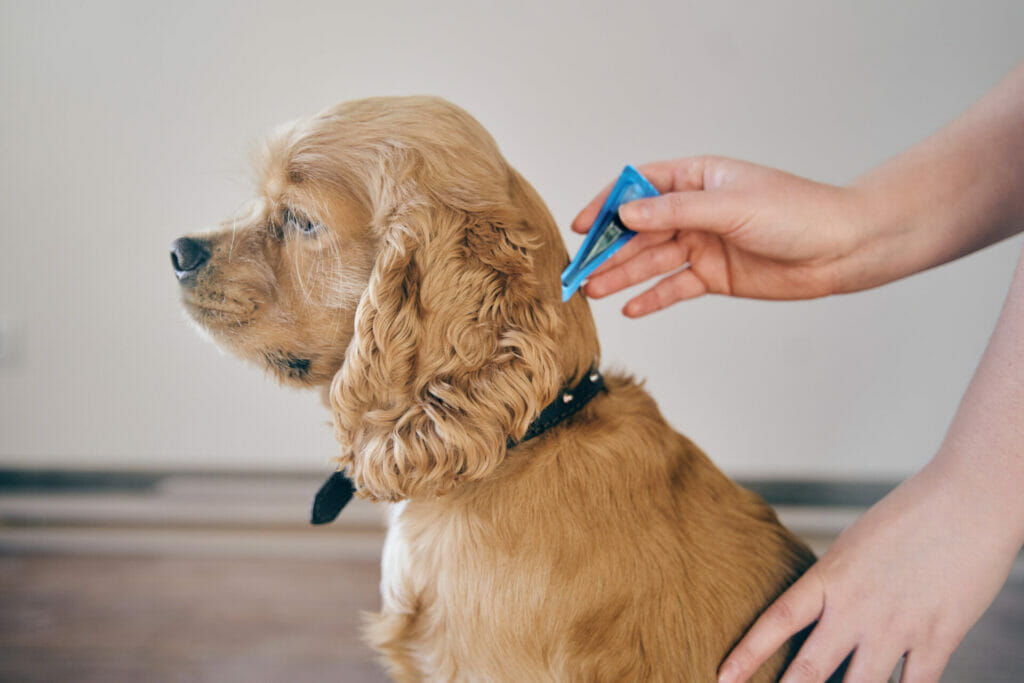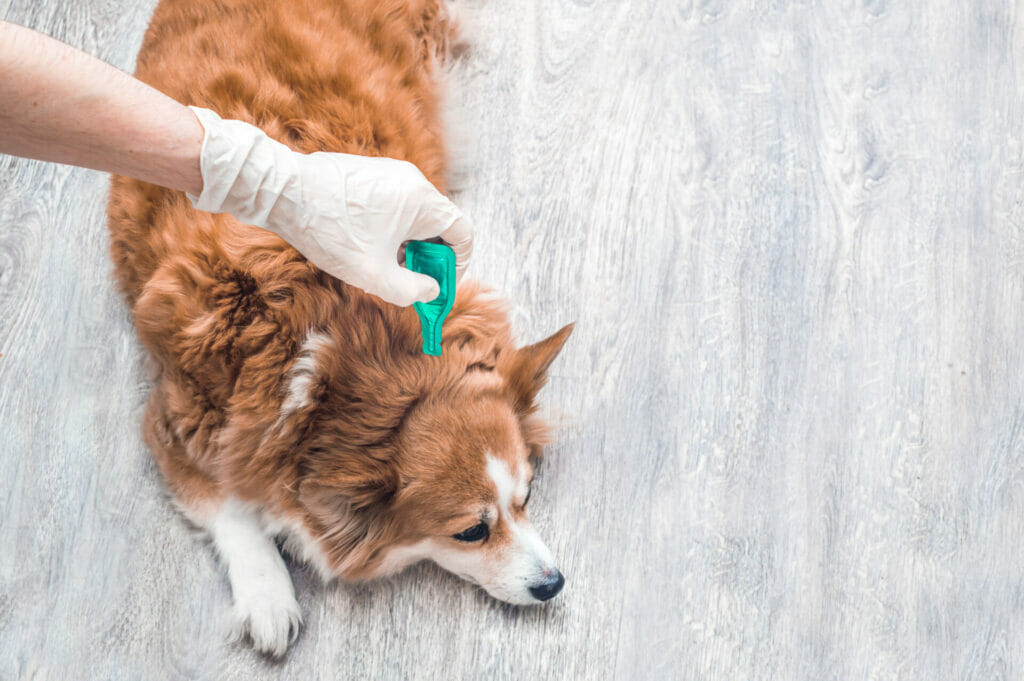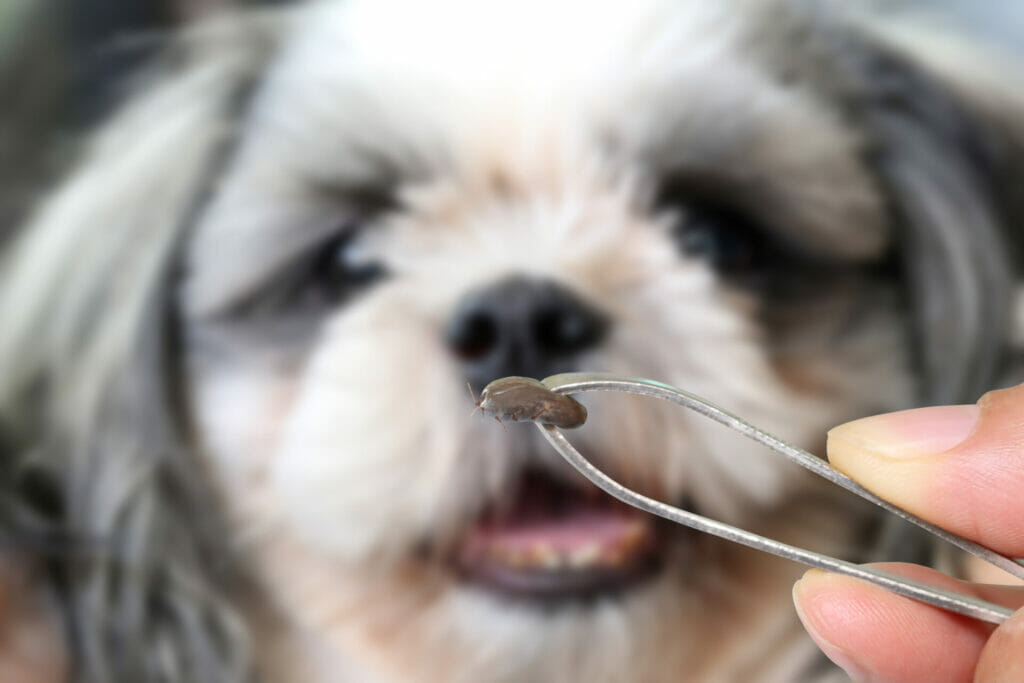Fleas and ticks are common external parasites that can infest dogs and cause a range of health issues. Potential concerns include skin irritation, allergic reactions, anemia, and the transmission of diseases. Therefore, dog owners need to use flea and tick medication as a preventative measure. In this blog, we share why flea and tick medication is important for dogs, especially in spring and summer.

Preventing Fleas and Ticks in Dogs
There are numerous flea and tick preventatives available on the market that are safer and more effective than what was available even several years ago. There are so many choices. However, you must always consider your dog’s safety when using a flea and tick preventative.
It is best to work directly with your veterinarian to decide on the right regimen that will fit your pet’s age, other health issues, and breed, as well as the environment you live or vacation in. Your vet will also consider whether you have more than one pup, have dogs that swim, or have young children in your household.
Options for flea and tick prevention products now include:
- oral medications and oral preventatives
- topical drops and topical treatment
- flea and tick collars
- shampoos
- sprays and wipes
- yard treatments
With the uptick of tick diseases and tick population in recent years, the more chemical-filled sprays seem more effective than the organic ones.
Tick Bites Cause Nasty Illnesses in Dogs
Ticks can cause infection, abscesses, paralysis, and even death. This is why tick prevention is critical. In addition, ticks are the host of several debilitating diseases, including Lyme disease, Rocky Mountain spotted fever, anaplasmosis, ehrlichiosis, and babesiosis.
What is Rocky Mountain Spotted Fever?
Rocky Mountain spotted fever (RMSF) is a bacterial disease spread through the bite of an infected tick. Most people who get sick with RMSF will have a fever, headache, and rash. RMSF can be deadly if not treated early with the right antibiotic.
The Centers for Disease Control and Prevention (CDC) warns that vaccines are not available for most tick-borne diseases dogs can get. These tick species and diseases can be very difficult to recognize and are easily misdiagnosed due to varied and vague symptoms. Treatments for tick-borne illnesses are also lengthy and can be very costly.
How Often Should I Check For Ticks?
Dr. Jerry Klein, Chief Veterinary Officer for the AKC, suggests that during tick season, in addition to using a preventative tick treatment often, it is critical to do a daily tick check on your dog. A tick bite will take about 12 hours to transmit the bacteria anaplasma and 24 to 36 hours to transmit Lyme disease. So it’s very important to locate and carefully remove ticks from your dog as quickly as possible.

Removing a Tick From Your Dog
Using a pair of tweezers is the most common and effective way to remove a tick. But not just any tweezers will work. Most household tweezers have large, blunt tips. You should use fine-point tweezers to avoid tearing the tick and spreading possible infections into the bite area.
Spread your dog’s fur, then grasp the tick as close to the skin as possible. Very gently, pull straight upward in a slow, steady motion. This will prevent the tick’s mouth from breaking off and remaining embedded in the skin. People often believe it’s the head of the tick that embeds in the skin. But ticks don’t have heads, in the conventional sense, so what gets inserted into your dog is known as “mouth parts.”
Grooming Dogs During Flea & Tick Season
When your dogs are bathed, it’s always a good idea to use a conditioner to help look through the hair and skin. The shampoos and conditioner from PRIDE+GROOM are especially conducive for thorough tick checks because they keep the hair and fur silky and detangled, making the search incrementally easier. It’s also important to have the proper tools to remove active fleas and ticks if found.
Why Are Fleas Dangerous?
While fleas don’t transmit Lyme disease, they can cause a terrible allergic reaction called flea allergy dermatitis, which can become painful and itchy for the dog. Fleas move around quickly and tend to jump and get lost easily on the body.
They leave behind flea excrement, which we call flea dirt, which looks like pepper. If you’re not sure if you’re finding flea-related dirt or regular dirt, you can do a test by pressing the black bits directly onto a wet paper towel. If you can see some brown or red “bleeding,” then what you’ve found is flea excrement, and you should speak to a veterinarian about sterilizing your home and clothing from possible eggs stemming from fleas.
Itching, scratching, redness, flaky skin, scabs, hot spots, and hair loss: if your pet has an allergy to fleas, you may observe these uncomfortable symptoms and more if they get fleas. The bite of one flea can send your dog into a whirlwind of scratching, biting, and digging at their skin.
Also, fleas are the most common cause of tapeworms. The first thing your pet will most likely do when bitten by a flea is chew at the spot where the bite is. Often, this results in your dog swallowing the flea. Fleas carry the larvae of the tapeworm, and these larvae will mature into adult tapeworms inside your pet’s intestines. Fleas have also been known to cause anemia from blood loss in very infested dogs.
How to Avoid Ticks and Fleas Without Using Harmful Chemicals?
Safe Treatments
It is possible to avoid harmful topical treatments and pet products that contain TCVP (Tetrachlorvinphos). Tick and flea prevention pet collars, dusts or powders, tick and flea treatments, and liquid sprays, often contain TCVP. Essentially, TCVP a chemical commonly used in topical treatments and pet products to kill fleas and ticks.
TCVP kills these pests, but also may be dangerous for pets and their owners, especially young children and pregnant women. Serious health problems have been linked to the harmful chemicals. The environmental community such as the National Resources Defense Council (NRDC) and seasoned pet owners, have suggested many safer alternatives for preventing fleas and ticks.
Pet Grooming
Grooming your pet regularly can be a great way to prevent ticks and fleas. Soap and water can kill adult fleas, and combing your pet with a fine-tooth flea comb can remove fleas, eggs, and other debris. Also, pests tend to be less attracted to clean animals. Check your pets daily for ticks and fleas, especially after spending time in a high-risk area.
Avoiding Woods or Grassy Areas
If possible, avoid areas with a high risk of tick and flea exposure, such as woods and tall grass areas.
House Cleaning: Vacuuming the places your dogs like to hang out, such as under furniture and their bedding, as well as washing your pet’s bed with soap and hot water, can get rid of fleas or flea eggs before they hatch. Do not forget to empty the vacuum container outside so the eggs do not hatch in your house.
Yard Maintenance
If you have a yard, keeping your grass mowed and leaves raked is important, as ticks and fleas like to breed in tall grass and leafy areas. Keeping your yard uninhabitable to tick and flea breeding can avoid possible pet exposures to pests.
Conclusion
Overall, flea and tick medications are an important tool for preventing infestations, controlling pest populations, and avoiding skin irritation and allergic reactions. It’s also found to help prevent anemia, prevent the transmission of diseases, and contribute to the overall health and well-being of dogs. By using flea and tick medication as a preventative measure, we can help keep their dogs happy, healthy, and free from parasites.




















